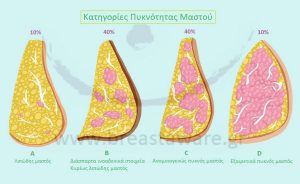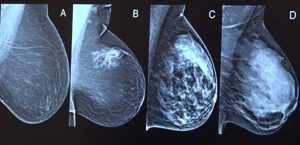
Breast Density: What It Means and Why It’s Important to Know
The dense breast is a term often used during mammological examination and especially in mammogram. It is not a disease, but mammographic feature, which affects diagnostic accuracy and monitoring strategy.
What Is Breast Density?
A dense breast is mainly composed of glandular tissue (lobules and milk ducts) and less than fat. This tissue appears white on mammogram, which makes it more difficult to detect possible lesions. The density it has nothing to do with size or cruelty of the breast and is more common in women under 35 years of age.
Breast Density Categories
Density is classified into four categories based on the ratio of fat to glandular tissue:
- Almost entirely fatty
- Scattered areas of fibroglandular density
- Heterogeneously dense
- Extremely dense
Categories 3 and 4 are defined as dense breasts.

Why Does Breast Density Matter?
Having dense breasts is a independent factor risk of breast cancer. Studies show that women with extremely dense breasts have up to 4–6 times greater risk cancer incidence compared to women with fatty breasts.
In addition, white glandular tissue can hide damage, such as calcifications or masses, which also appear white, thus reducing the sensitivity of mammography.
What Should I Do If I Have Dense Breasts?
If the mammogram shows that you have dense breasts, Don't panic. Your doctor will assess if necessary. additional imaging examination, based on it your medical history and of breast imaging findings
Supplementary Examinations
For women with dense breasts, the following may be recommended:
- Breast ultrasound: Complements mammography, especially in younger women.
- Breast MRI: Highly sensitive, detects cancers not visible on other imaging; useful in extremely dense tissue but may have higher false-positive rates.
- Digital Tomosynthesis (3D Mammography): Improves image resolution and reduces recall rates, though it involves slightly higher radiation dose and cost.
What Do Official Guidelines Say?
The American College of Radiology (ACR) and U.S. Preventive Services Task Force (USPSTF) recommend personalized approach for women with dense breasts, especially when other risk factors coexist, such as gene mutations (BRCA1/2) or strong family history.
The simple mammogram maybe it's not enough in all cases and the choice of tests must be made in consultation with the treating physician.
Learn More at breastaware.gr
At breastaware.gr you will find reliable and understandable information about everything related to the breast — from imaging tests to prevention and care. Our goal is for every woman to feel empowered, informed and safe.
Bibliography:
- Boyd NF, et al. Mammographic density and the risk and detection of breast cancer. N Engl J Med. 2007;356(3):227-36.
- Brentnall AR, et al. Mammographic density and screening sensitivity, breast cancer risk, and false-positive rates. Am J Epidemiol. 2015;182(1):33-40.
- Kerlikowske K, et al. Identifying women with dense breasts at high risk for interval cancer: a cohort study. Ann Intern Med. 2015;162(10):673-81.
- Hooley RJ, et al. Screening US in patients with mammographically dense breasts: initial experience with Connecticut Public Act 09-41. Radiology. 2012;265(1):59-69.
- Bakker MF,et al. Supplemental MRI screening for women with extremely dense breast tissue. N Engl J Med. 2019;381(22):2091-102.
- Melnikow J, et al. Supplemental Screening for Breast Cancer in Women With Dense Breasts: A Systematic Review. Ann Intern Med. 2016;164(4):268-78.
- American College of Radiology. ACR BI-RADS Atlas – Breast Imaging Reporting and Data System. 5th ed. Reston, VA: American College of Radiology; 2013.
- Monticciolo DL, et al. Breast cancer screening recommendations inclusive of all women at average risk: Update from the ACR and Society of Breast Imaging. J Am Coll Radiol. 2021;18(7):1120-8.
